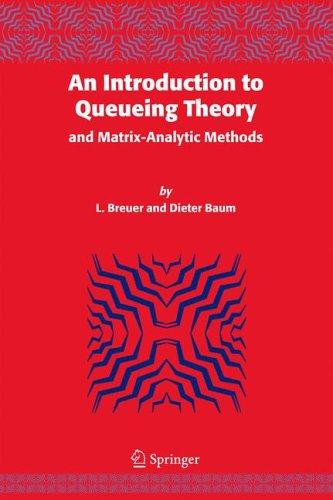An Introduction to Queueing Theory - Info and Reading Options
and Matrix-Analytic Methods
By L. Breuer and Dieter Baum

"An Introduction to Queueing Theory" is published by Springer in December 7, 2005, it has 271 pages and the language of the book is English.
“An Introduction to Queueing Theory” Metadata:
- Title: ➤ An Introduction to Queueing Theory
- Authors: L. BreuerDieter Baum
- Language: English
- Number of Pages: 271
- Publisher: Springer
- Publish Date: December 7, 2005
“An Introduction to Queueing Theory” Subjects and Themes:
- Subjects: ➤ Markov-processen - Waarschijnlijkheidstheorie - Queuing theory - Wachttijdproblemen - Markov processes - Matrices - Computer networks - Computer science - Computer system performance - Distribution (probability theory) - Mathematics - Qa274.8 .b74 2005 - Computer Communication Networks
Edition Specifications:
- Format: Hardcover
- Weight: 1.2 pounds
- Dimensions: 9.5 x 6.3 x 0.8 inches
Edition Identifiers:
- The Open Library ID: OL8371551M - OL16988638W
- Online Computer Library Center (OCLC) ID: 62363721
- Library of Congress Control Number (LCCN): 2007298332
- ISBN-13: 9781402036309
- ISBN-10: 1402036302
- All ISBNs: 1402036302 - 9781402036309
AI-generated Review of “An Introduction to Queueing Theory”:
"An Introduction to Queueing Theory" Description:
The Open Library:
The present textbook contains the recordsof a two–semester course on que- ing theory, including an introduction to matrix–analytic methods. This course comprises four hours oflectures and two hours of exercises per week andhas been taughtattheUniversity of Trier, Germany, for about ten years in - quence. The course is directed to last year undergraduate and?rst year gr- uate students of applied probability and computer science, who have already completed an introduction to probability theory. Its purpose is to present - terial that is close enough to concrete queueing models and their applications, while providing a sound mathematical foundation for the analysis of these. Thus the goal of the present book is two–fold. On the one hand, students who are mainly interested in applications easily feel bored by elaborate mathematical questions in the theory of stochastic processes. The presentation of the mathematical foundations in our courses is chosen to cover only the necessary results, which are needed for a solid foundation of the methods of queueing analysis. Further, students oriented - wards applications expect to have a justi?cation for their mathematical efforts in terms of immediate use in queueing analysis. This is the main reason why we have decided to introduce new mathematical concepts only when they will be used in the immediate sequel. On the other hand, students of applied probability do not want any heur- tic derivations just for the sake of yielding fast results for the model at hand.
Read “An Introduction to Queueing Theory”:
Read “An Introduction to Queueing Theory” by choosing from the options below.
Search for “An Introduction to Queueing Theory” downloads:
Visit our Downloads Search page to see if downloads are available.
Find “An Introduction to Queueing Theory” in Libraries Near You:
Read or borrow “An Introduction to Queueing Theory” from your local library.
- The WorldCat Libraries Catalog: Find a copy of “An Introduction to Queueing Theory” at a library near you.
Buy “An Introduction to Queueing Theory” online:
Shop for “An Introduction to Queueing Theory” on popular online marketplaces.
- Ebay: New and used books.